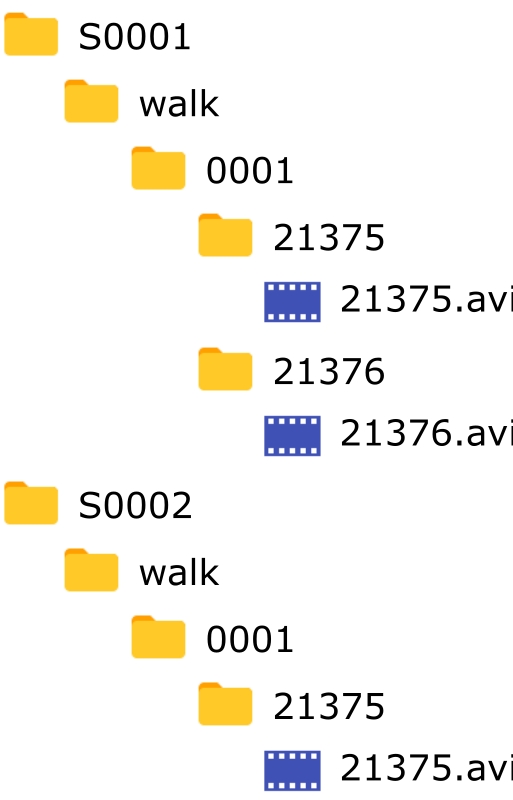Organize Videos
Organize Videos
The Organize Videos tool converts a folder of videos into a structure that can be used by Theia3D. This functionality is useful when collecting large data sets.
Video names must not contain accents, as these can cause errors during the Organize Videos process. Use only alphanumeric characters with space, hyphen (-), underscore (_), or period (.) as delimiters. Avoid using commas (,) or semicolons (;).
Basic
The Basic tab is the best option when organizing videos that have user-defined file names, such as those collected using OptiTrack, Qualisys, or Vicon camera systems. To use this tool, it is recommended to include relevant details about the trial as part of the file name, consistently separated by one delimiter from the following options:
Space (' ')
Hyphen ('-')
Underscore ('_')
Period ('.')
Space (' ') and Underscore ('_')
With video files named in this way, the dropdown options below can be assigned to each delimited portion of the filename, resulting in an intuitive file structure that maintains this information for each trial:
Cam ID: (Required) The ID of the camera corresponding to the video file. This must be the same ID as in the calibration file.
Subject: (Recommended) Unique subject identifier (e.g. sub001).
Action: (Recommended) The action the subject is performing (e.g. walk).
Trial: (Recommended) The trial number (e.g. 001 or walk01).
N/A: (Optional) Additional terms in the filename not used by Theia3D.
Acceptable delimiters include space (' '), hyphen (-), underscore (_), period (.), or space and underscore (' ' and _). Delimiters that should not be used include comma (,) and semi-colon (;).

To format video data using this tool, follow the steps below:
Select the delimiter used in the file name.
Use the Browse button to select the folder containing the videos. Once the directory has been selected, the dialog will parse the name of a sample file. Note that the delimiter can be changed after the folder is selected and the sample file name will be re-parsed.
Use the drop down menus to select the reserved term that each part of the filename corresponds to.
Click Execute to organize the data into the required structure. The hierarchy of the created directory is Subject > Action > Trial > Cam ID. Cam ID is the only reserved term that must be included in the filename; however, it is recommended to include any other relevant details about the trial as part of the filename.
For example, consider a folder with the following video names:
S0001_Walk_001_8_21375.avi
S0001_Walk_001_8_21376.avi
S0002_Walk_001_8_21375.avi
To format these videos, the reserved terms selected are: Subject, Action, Trial, N/A, and Cam ID. The data structure after formatting is:

Top Level Only
When enabled, this option sorts only the video files located directly within the current folder. Any subfolders and the files they contain are ignored during the sorting process. This ensures that only the top-level contents are affected, and can be useful when adding new, unorganized data into a folder with existing, organized data.
Advanced
The Advanced tab is the best option when organizing videos that do not have user-defined file names, such as those collected using Sony RX0 II camera systems. To use this feature, the names of the video files must end with camid_trialid, where camid is the ID of the camera that recorded the video and trialid is a unique identifier for the trial.
When exporting videos using the Sony RX0 II camera system browser interface, make sure that the Name of Imported File options are selected as follows:
Add the Camera Label (prefix)
Do not add the Shooting Date/Time


To format video data using this tool, follow the steps below:
Use the Browse button to select the folder containing the videos. The trials table is then created with one row for each trial. The File column of each rorow is filled with the trialid for that trial.
Use the Load Subject and Action Assignments button to load the subject and action IDs for each of the trials from a csv file. Each row of the csv file must contain the trialid, subjectid, and actionid of a single trial, in that order, separated by commas. For example, the csv file used to assign the subject and action IDs in the above figure was:
Press the Execute button to format the videos in the required folder structure.
Alternatively, Subject and Action details can be manually assigned to the trials table without using a CSV file:
Double click any cell to type in the Subject or Action ID.
Click Save Subject and Action Assignments to save the filled table as a CSV.
Press Execute to format the videos in the required folder structure.
Last updated
Was this helpful?

